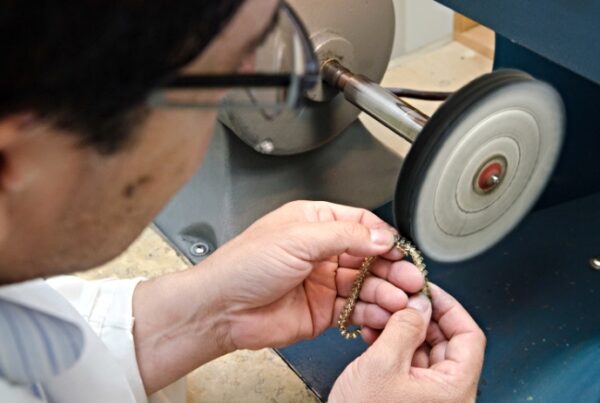Watch Lover’s Guide | The Amazing Mechanical Watch
For the true watch aficionado, nothing can compare to the feat of engineering and design artistry required to create a fine mechanical watch. These intricate movements require special care to protect them from unnecessary damage. This article explains how mechanical movements work and how to properly care for them.
What is a Mechanical Watch?
It is all about the power source. Quartz watches run on batteries for their power. Mechanical watches are powered by the release of energy created by the unwinding of a flat spring, called the main spring.
The rate of the energy released is controlled by a series of delicate, interacting parts such as gears, cogs, and springs. Some of these parts are so tiny that your breath could send them flying. The parts work in exquisite synchronization to evenly release the power of the watch’s mainspring for accurate time.
There are two types of mechanical movements: Hand-wound movements and automatic movements.
Hand-wound Movements
Hand-wound mechanical watches should be wound at the same time every day, even when not in use. This will keep the mainspring at the optimum tension for continued accuracy and lubricants from becoming sticky.
When winding, take your watch off your wrist. Winding your watch while it is being worn can put undue pressure on the winding stem and cause damage.
Be careful not to over-wind your watch. Turn the crown gently until you feel the slightest resistance – then stop! Never force the winding mechanism.
Automatic Movements
These watches get their power from the normal movement of your wrist. You only have to manually wind this type of watch if you stop wearing it or if you are extremely inactive.
If you don’t wear your automatic watch regularly, invest in a quality watch-winding box. These boxes provide enough movement to keep your watch running regularly and set at the right time.
Setting The Time
To set the time, remove the watch from your write. Gently pull the crown all the out, turn it until the second hand engages, and rotate the hands clockwise to the correct time. Make sure that the hands have moved past the 2 am mark at least once before resetting the crown.
If you miss your mark for the correct time, keep rotating the hands clockwise around the dial until you reach the proper time. Do not run the hands counter clockwise.
Setting The Date
If you have a watch with a date, never set the date when the watch time is between 9pm, and 3 am. The date changing mechanism is engaged at that point. Setting the date between those hours can strip the delicate watch gears.
Hand-wound movements are a bit sturdier than automatic movements, so be especially gentle when setting your automatic watch.
Protect from Moisture
Moisture is the grim reaper for mechanical watches. The best way to protect the mechanism is to remove your watch during any activities that involve water, especially once the watch is a couple of years old. Keep it protected under your sleeve when it is raining or snowing.
For swimmers, use a diving watch that has a water resistant rating down to 200 meters. Even with that deep a rating, the chlorine in pools can be damaging and salt water can affect your watch case and strap.
Temperature Alert
Do not subject your watch to extremes in temperatures. When entering a warm environment from a cold one, do not use artificial means to warm your watch. Use only the temperature of your body by continuing to wear it.
If you notice condensation under the crystal, get your watch serviced immediately. Moisture can quickly rust your watch’s interior. Do not wear or store your watch in extremely high temperatures or under very damp conditions.
Shock
Your watch has parts that function as shock absorbers. They help to protect the mechanism from the jarring caused by normal movement. Do not wear your watch is you plan to engage in any manual labor or sports that can cause excessive striking of your timepiece. Examples include weight training, golf, basketball, and soccer. In those instances, use a battery operated watch.
Magnets
Electronic equipment such as sound speakers, televisions, and computers have magnetic fields that can affect your watch’s precision and sometimes stop it completely. If your watch suddenly stops keeping accurate time, take it to a certified watchmaker. It can be demagnetized in just a few minutes.
Watch Crystals
While older watches may have acrylic crystals, today’s luxury watches use sapphire crystals. These are much more scratch-resistant than other materials, but they are not shatter-proof. If you have a watch with a scratched acrylic crystal, all by the deepest scratches can easily be polished out.
Exterior
Wearing your watch on a regular basis will result in an accumulation of debris around the case and watchband. Use a soft brush to gently brush away skin cells and other accumulations around the case and where the watchband is attached.
Professional Service
Your watch parts are subject to wear as they age due to friction, lubricant break down, and repeated shock absorption. The tiny teeth on the gears, jewel bearings, gaskets, and lubrication all deteriorate. It is recommended that your watch be serviced every two to seven years.
Proper cleaning and servicing a mechanical timepiece is not inexpensive, but it will help to keep your watch working for decades. These procedures are delicate, time-consuming operations requiring many precise steps, special equipment, and exacting quality-testing procedures.
Your Enduring Timepiece
With the proper care and servicing of your mechanical watch, you will have your time-keeping companion for decades. Many mechanical watches have continued to keep time for more than one hundred years! We hope you will enjoy your amazing mechanical watch for many years.
For additional information, we recommend the following resources:
Hub Pages, “Care for Your Wind Up Mechanical Watch” by Dr. Roberting: http://drroberting.hubpages.com/hub/caring-for-your-mechanical-watch
Fondation de la Haute Horlogerie, “The History of Watchmaking”: http://www.hautehorlogerie.org/en/encyclopaedia/history-of-watchmaking/
History of Watches, “History of Automatic Watches”: http://www.historyofwatch.com/watch-history/history-of-automatic-watch/
Tourneau, “A History of Time Keeping, Historical Timeline”: http://www.tourneau.com/catalog/editorial_onecolumn.jsp?pageName=HistoryOfTimeKeepingTimelinev




